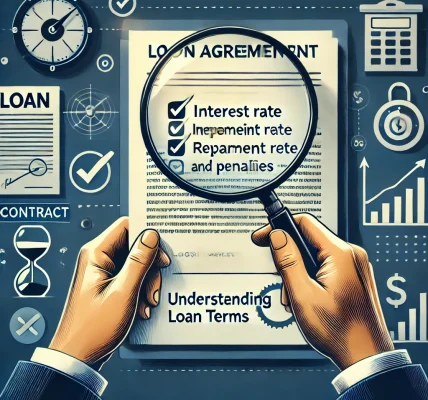Understanding loan terms and conditions is essential to ensure a smooth borrowing experience and avoid hidden costs. Lenders include various clauses in loan agreements that can impact your repayment process. This guide will help you decode the key loan terms and conditions before signing any contract.
1. Loan Principal
The principal is the total amount you borrow from the lender.
- The higher the principal, the more interest you’ll pay over time.
- Always borrow only what you genuinely need to avoid excessive debt.
2. Interest Rate
The interest rate determines the cost of borrowing and varies based on the lender, loan type, and credit score.
Types of Interest Rates:
- Fixed Interest Rate: Stays the same throughout the loan term.
- Floating Interest Rate: Changes based on market conditions.
- Reducing Balance Interest Rate: Interest is charged only on the outstanding loan balance, leading to lower costs over time.
Tip: Compare different lenders to find the lowest interest rate.
3. Annual Percentage Rate (APR)
APR includes the interest rate plus additional fees (processing charges, service fees, etc.).
- A lower APR means a more affordable loan.
- Always compare APR, not just the interest rate, to get the true cost of borrowing.
4. Loan Tenure (Repayment Period)
Loan tenure refers to the duration within which you must repay the loan.
- Shorter tenure: Higher monthly EMIs but lower interest costs.
- Longer tenure: Lower EMIs but higher overall interest payments.
Tip: Choose a tenure that balances EMI affordability with minimal interest costs.
5. Equated Monthly Installments (EMIs)
EMI is the fixed monthly payment that includes both principal and interest.
- Use an EMI calculator to estimate your monthly payment before applying.
- Ensure that your total EMI payments do not exceed 40% of your monthly income to maintain financial stability.
6. Prepayment & Foreclosure Charges
If you want to repay your loan early, check for:
- Prepayment charges – Fees for making extra payments before the loan term ends.
- Foreclosure charges – Penalties for paying off the loan in full before maturity.
Some lenders offer zero prepayment fees, making it easier to close loans early.
7. Late Payment Penalties
Missing EMI payments can lead to:
- Late fees (a fixed amount or percentage of EMI).
- Higher interest rates for future loans.
- Negative impact on credit score, reducing future borrowing ability.
Tip: Set reminders or opt for auto-debit to avoid penalties.
8. Processing & Other Fees
Many loans come with hidden charges. Look out for:
- Processing fees (0.5% – 3% of loan amount).
- Legal/documentation charges.
- Loan insurance fees (mandatory in some cases).
Tip: Always read the fine print to understand the true cost of borrowing.
9. Loan Default Terms
If you fail to repay the loan:
- The lender can take legal action.
- Your credit score will drop, affecting future loan approvals.
- In the case of a secured loan, the lender can seize the collateral (house, car, etc.).
Tip: Choose a loan with a grace period to avoid penalties for minor delays.
10. Collateral & Guarantor (For Secured Loans)
- Secured loans require collateral (house, gold, car) as security.
- Unsecured loans (personal loans) do not need collateral but may have higher interest rates.
- Some loans require a guarantor, who will be responsible if you fail to repay.
Tip: Only pledge assets you can afford to lose in case of default.
Final Thoughts
Before signing any loan agreement, carefully read and understand all terms and conditions. Compare different lenders, check for hidden fees, and ensure that the repayment plan suits your financial capacity.


